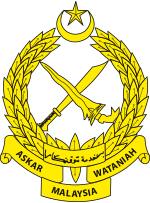Rejimen Askar Wataniah
| Malaysian Territorial Army Regiment Rejimen Askar Wataniah |
|
|---|---|

Crest of the Malaysian Army Territorial Army Regiment
|
|
| Active | 1 June 1958 – present |
| Country |
|
| Branch | Malaysian Army |
| Type | Military reserve force |
| Size | 78,000 active personnel |
| Part of | Malaysian Armed Forces |
| Motto(s) |
Berkhidmat Untuk Negara (Serve for the Country) |
| Engagements |
Indonesia–Malaysia confrontation Communist insurgency in Malaysia (1968–89) |
The Rejimen Askar Wataniah (Territorial Army Regiment) is the military reserve force of the Malaysian Army. An equivalent formation in the British Army would be the Territorial Army.
The Regiment infantry units formerly consisted of 2 series of reservist; the mobilised 300 series and the volunteer 500 series. The 300 series, which consisted of 5 infantry battalions, with mobilised reservists for full-time duty, have since 2008 been converted into a new regular border regiment, the Rejimen Sempadan. The 500 series are reserve volunteers units, based in major towns and cities throughout the whole country. In all there are about sixteen 500 series infantry battalions, in addition to other support and service support reserve units.
In 1861, the Penang Volunteers were formed as a volunteer army unit of the Straits Settlement. Similar units were formed in Singapore and in the other Malay States.
In 1902, the Federated Malay States formed the Malay State Volunteer Rifles (MSVR) volunteer force. The Unfederated Malay States also formed their own volunteer units. With further expansion, the formations were then known as the Federated Malay States Volunteer Force (FMSVF), Unfederated Malay States Volunteer Force (UFMSVF) and the Straits Settlement Volunteer Force (SSVF).
With the outbreak of the Second World War, the volunteer units were mobilised and fought alongside the regular British, Indian and Australian troops in the defence of Malaya and Fortress Singapore.
During the Japanese Occupation of Malaya, the Chinese dominated Malayan People's Anti-Japanese Army conducted guerrilla warfare against the Japanese occupiers. As only the regular Malay Regiment led by British officers had acquitted itself well until the surrender in Singapore (February 1942), the British felt it was possible to involve Malays in the resistance against the Japanese but only with extensive training and by working in close co-operation with the stay behind British forces. The British desperately needed Malay resistance fighters to operate in Malay dominated areas. During the Japanese Occupation, a number of local Malays formed resistance groups and carried out guerrilla warfare against the Japanese. Resistance units in Pahang were called WATANIAH, derived from the Arabic word WATAN (state). The Wataniah was led by Yeop Mahidin Bin Mohamed Shafiff (known as the Father of Wataniah). Force 136 of the Special Operations Executive was amongst the British formations that co-ordinated the Malayan resistance (including the Wataniah movement) against the Japanese.
...
Wikipedia
